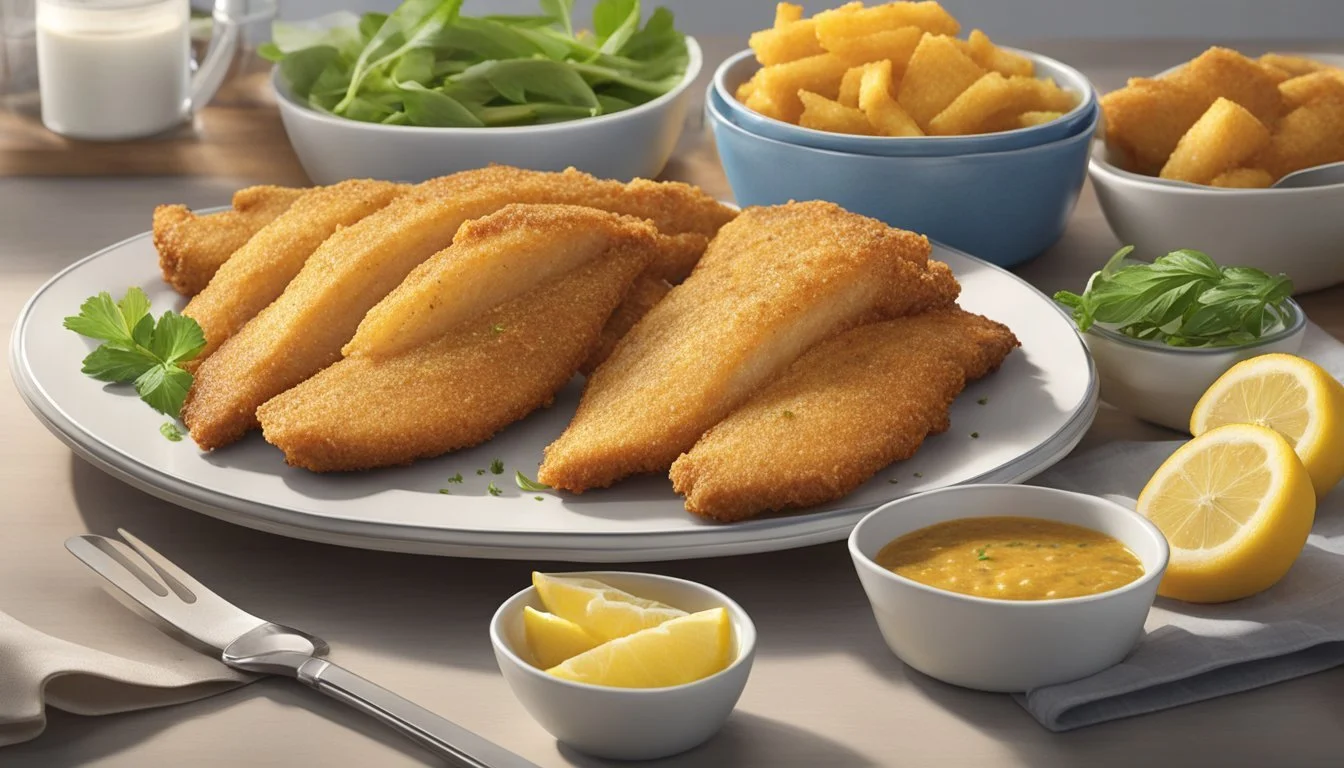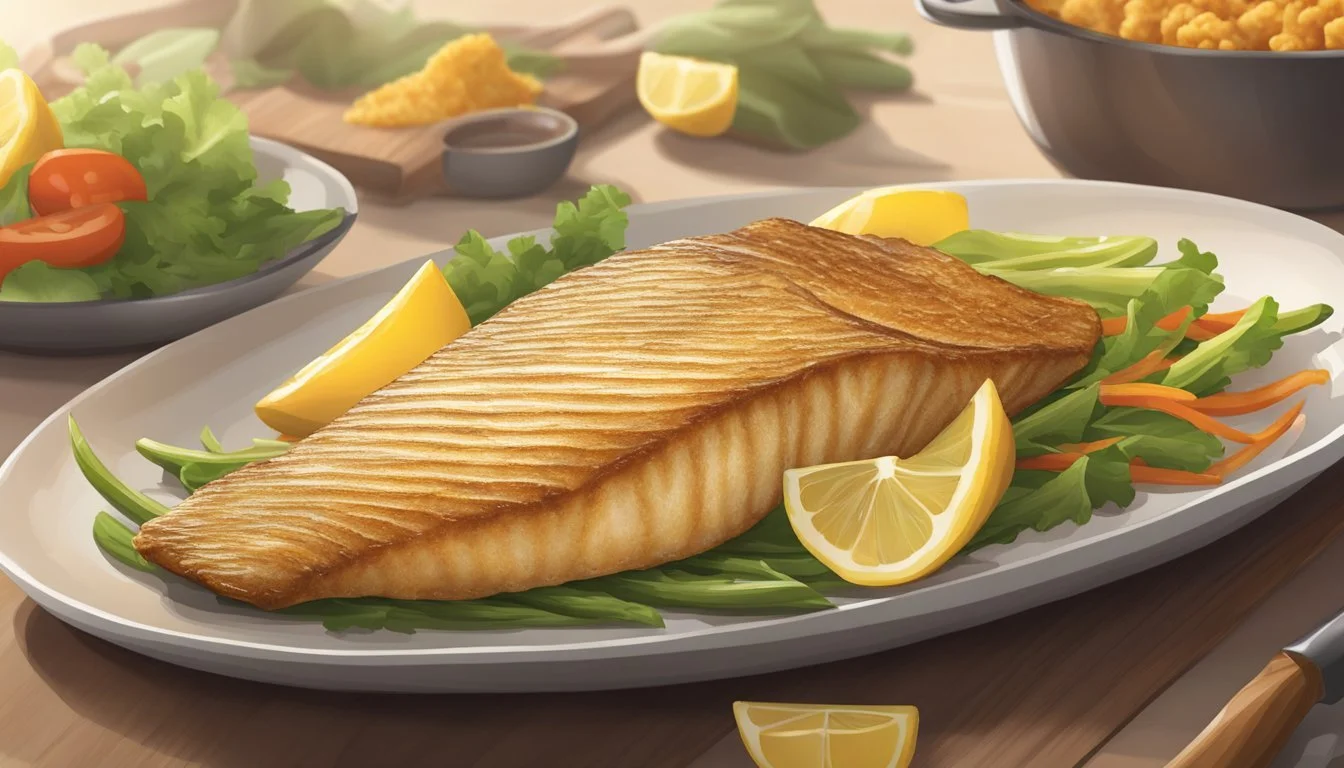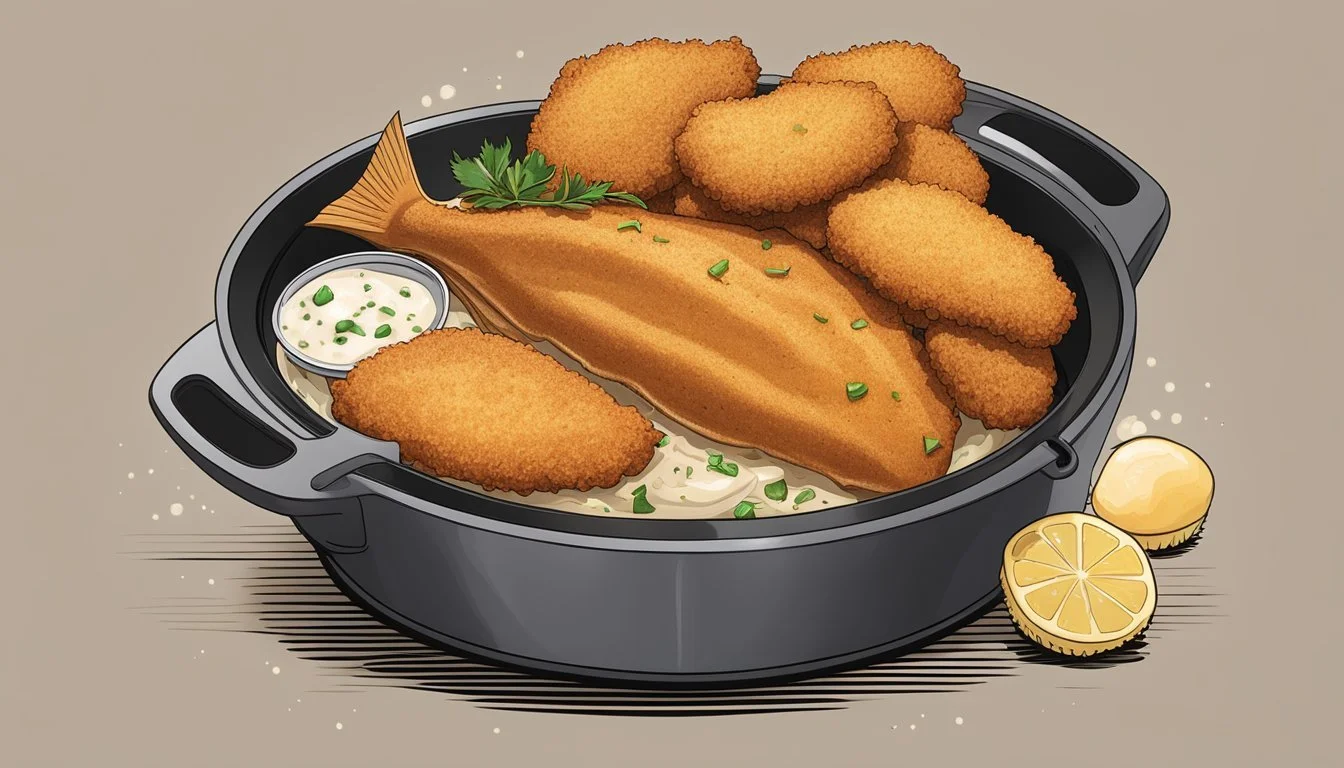Air Fryer Catfish
How to Enjoy a Healthier Southern Classic
Air Fryer Catfish represents a culinary innovation that aligns the rich heritage of Southern cuisine with contemporary health consciousness. Traditionally deep-fried, catfish has long been a staple in the Southern United States, known for its crispy exterior and flaky texture. By using an air fryer, this beloved dish retains its signature taste and satisfying mouthfeel but with significantly less oil, resulting in a lighter meal that is easier on the waistline.
The preparation of catfish in an air fryer involves a balance of spices and breading that complements the mild flavor of the fish. A combination of cornmeal, flour, and a select mixture of seasonings such as garlic powder, onion powder, cayenne, and paprika typically coats the fish, providing a flavorful crust. This breading process, followed by cooking in an air fryer, achieves the desired crispiness without the need for submersion in oil.
Forgoing the deep frying doesn't mean a sacrifice in taste; in fact, it can enhance the natural flavors of the catfish. Soaking the fish in buttermilk or a light coating of egg before breading not only ensures that the coating adheres but also adds a subtle tang and tenderness to the fish. Whether one prefers a classic taste or a hint of zest, the air fryer catfish can be adapted to suit any palate while serving as a heart-healthy alternative to an age-old Southern delicacy.
History and Significance of Catfish in Southern Cuisine
Catfish has long been a staple in Southern cuisine, holding a place of cultural significance and contributing to the region's reputation for hearty comfort food.
Catfish in Cultural Context
In the Southern United States, catfish has transcended its status as just another fish to become deeply ingrained in cultural traditions. Often associated with communal gatherings and family-centric events, catfish is more than a comfort food; it reflects a sense of home and community. Its significance is partly rooted in the historical diets of enslaved African Americans in the South, particularly in the Mississippi River Valley, who relied on readily available catfish for sustenance. Over time, catfish has been embraced across various Southern social spaces, notably in celebrations of Emancipation and Independence Day.
Evolution of Catfish Cooking Methods
Southern-style catfish traditionally involves dredging the fish in a seasoned cornmeal mixture before frying it to perfection. This method offers a combination of a crispy exterior with tender, flavorful meat. However, the cooking methods have evolved:
Classic Southern Frying: A centuries-long tradition where catfish is deep-fried in oil.
Modern Takes: Contemporary health trends have popularized the use of air fryers for a healthier version of this classic dish. An air fryer provides a crispy texture similar to traditional frying but uses significantly less oil, which reduces calorie content.
Whether cooked using classic methods or modern appliances, the taste and cultural legacy of Southern-style catfish as a beloved dish of the South remain unchanged.
Health Benefits of Air Fryer versus Traditional Frying
The air fryer offers distinct health advantages over traditional frying by drastically reducing oil usage and caloric content while maintaining the nutritional value of the food.
Reduced Oil Usage and Caloric Content
Traditional deep frying submerges the food in significant amounts of oil, which the food absorbs, resulting in a higher fat and calorie content. Air frying, by contrast, utilizes hot air that circulates around the food, requiring as little as a tablespoon of oil.
Fat content: Deep-fried catfish can soak up oil, leading to a higher fat content. Air frying can reduce the oil needed by up to 80%, effectively lowering the total fat.
Calories: Calories in deep-fried foods are higher due to oil absorption. Air frying can cut calorie content by using less oil, with some recipes requiring no oil at all.
Maintaining Nutritional Value
The nutritional value of food can be better preserved with an air fryer. Hot air cooking methods are believed to retain more nutrients compared to the aggressive oil bath of deep frying.
Vitamins: Water-soluble vitamins like Vitamin C and some B vitamins are more likely to be retained during air frying.
Minerals: The gentle cooking process of air frying helps in preserving minerals like iron and zinc that are vital for health.
Using an air fryer, one can enjoy the golden crispness of a Southern catfish delicacy with a notable reduction in fat and calories and a preservation of nutritional benefits.
Selecting the Best Catfish for Air Frying
Choosing the right catfish is crucial for achieving the perfect balance of flakiness and flavor when air frying. One should consider both freshness and the source, be it farm-raised or wild-caught, to ensure the best outcome for this popular seafood dish.
Freshness Indicators
When selecting fresh catfish, there are several indicators one should look for:
Appearance: The fish should have a shiny, moist exterior with a slippery feel. If the catfish has a dull appearance or feels slimy, it may not be fresh.
Smell: Fresh catfish should smell mild and fresh, not fishy or sour.
Texture: The flesh should be firm to the touch and spring back when pressed. If the flesh is mushy, it suggests the fish is past its prime.
Eyes: Ideally, the eyes should be clear and slightly bulging. Cloudy or sunken eyes are signs of age.
Gills: The gills should be a rich red color. A faded or discolored appearance indicates a lack of freshness.
Farm-Raised vs Wild-Caught
The debate between farm-raised and wild-caught catfish centers on taste and sustainability:
Farm-Raised Catfish:
Flavor: Often milder because of the controlled diet and environment in which the fish are raised.
Texture: Typically more consistent in texture compared to their wild counterparts.
Availability: Generally more readily available throughout the year.
Sustainability: Farm-raising can be more sustainable if done responsibly, as it doesn't affect wild populations.
Wild-Caught Catfish:
Flavor: May have a more varied taste due to their natural diet in rivers and streams.
Texture: Can be firmer and flakier than farm-raised varieties.
Availability: Subject to fishing seasons and regional availability.
Sustainability: Wild populations can be impacted by overfishing, but responsible practices ensure long-term viability.
Preparing Catfish for Air Frying
Before diving into the air frying process, it is crucial to properly prepare the catfish. The preparation phase involves cleaning and filleting the fish, soaking it in a flavorful marinade or brine, and coating it with a well-seasoned breadcoat. These steps are essential to achieving the perfect texture and flavor in the finished dish.
Cleaning and Filleting
The initial step is to ensure the catfish are thoroughly cleaned and filleted. One should rinse the catfish under cold water to remove any remaining slime or impurities. Filleting the catfish involves cutting away the bones and skin, resulting in even-sized fillets which cook uniformly in the air fryer.
Marination and Brining
Marination or brining the catfish fillets enriches them with flavor and moisture. A common practice is to submerge the fillets in buttermilk or milk, possibly seasoned with hints of lemon or other desired flavors, for at least an hour. This not only imbues the catfish with a mild taste but also helps tenderize the meat.
Ingredients for Marination:
Buttermilk or milk
Optional: Lemon juice, garlic, herbs, and spices
Drying and Breadcoat Preparation
After marination, the catfish fillets should be patted dry. Preparing the breadcoat involves mixing dry ingredients such as yellow cornmeal, flour, and simple spices. One should ensure each fillet is evenly coated with the breadcoat mixture before air frying, as this will create a desirable crispy exterior.
Breadcoat Ingredients:
1 cup yellow cornmeal
1/2 cup all-purpose flour
Salt and pepper to taste
Optional: Paprika, garlic powder, onion powder
With the catfish fillets properly prepared, they're ready to be cooked, ensuring that classic Southern flavor with a healthier twist thanks to the air fryer's ability to crisp without deep frying.
Air Fryer Catfish Recipe
Preparing catfish in an air fryer not only creates a dish with a crispy texture but also significantly reduces the calories and fats as compared to traditional frying methods. Achieving a golden brown color and ensuring proper internal doneness is effortless with the precise temperature control of an air fryer.
Ingredients and Substitutes
Ingredients:
Catfish fillets
1 cup of cornmeal
1/2 cup of all-purpose flour
1/2 cup of grated Parmesan cheese (optional)
1 teaspoon of garlic powder
1 teaspoon of onion powder
1/2 teaspoon of cayenne pepper (adjust for heat preference)
1 teaspoon of paprika
Salt and black pepper, to taste
1 egg
1/2 cup of buttermilk (substitute with regular milk if buttermilk is unavailable)
Olive oil spray for coating
Substitutes:
For those with a dairy allergy, almond or soy milk can replace the buttermilk.
With gluten sensitivities, gluten-free flour blends may substitute traditional flour.
Step-by-Step Cooking Instructions
Preparation:
Pat the catfish fillets dry and set aside.
If using, soak the fillets in buttermilk for 20 minutes to enhance the taste; this step is optional.
Seasoning Mix:
In a dish, combine cornmeal, flour, Parmesan cheese, garlic powder, onion powder, cayenne pepper, paprika, salt, and pepper.
Egg Mixture:
In a different dish, beat the egg and mix with buttermilk.
Coating the Fish:
Dip each fillet into the egg mixture, ensuring both sides are covered.
Then dredge the fillets in the seasoning mix until well coated.
Air Frying:
Preheat the air fryer to 400°F (about 200°C) for 2-3 minutes.
Spray the air fryer basket with olive oil spray.
Place fillets in the basket, not overlapping, and spray the tops with olive oil spray.
Cook for 10 minutes, carefully flip the fillets, and continue to cook for an additional 10 minutes or until they reach the desired cripsiness and internal temperature.
The fish is done when it reaches an internal temperature of 145°F and has a crispy, golden brown exterior. Always ensure catfish is cooked thoroughly before serving.
Customizing the Recipe
Crafting the perfect air fryer catfish to suit individual tastes and dietary needs allows for a personalized touch to this southern staple. From selecting alternative ingredients to meet gluten-free diets to enhancing the dish with a variety of spices, customization is key for a successful culinary experience.
Adjusting for Dietary Restrictions
For those following a gluten-free diet, traditional flour can be substituted with a gluten-free flour blend or almond flour. Ensure that your cornmeal is labeled gluten-free as well. This modification does not compromise the texture or flavor of the catfish and allows everyone to enjoy a healthier version of this dish.
List of Gluten-Free Breading Alternatives:
Gluten-free flour blend
Almond flour
Gluten-free cornmeal
Note: Always double-check that all seasoning blends used are gluten-free, as they can sometimes contain gluten as a filler.
Experimenting with Flavors and Spices
The traditional southern catfish flavor profile often includes a kick from spices such as cayenne pepper and black pepper. To experiment with flavor, one can incorporate additional spices like Cajun or Creole seasoning, which provide a robust taste characteristic of Louisiana cuisine.
Key Spices to Consider:
Cajun seasoning: A blend with paprika, garlic powder, onion powder, and cayenne pepper.
Creole seasoning: Similar to Cajun but with herbs like parsley and sometimes mustard.
Lemon: Adding lemon juice or serving with lemon wedges can introduce a zesty freshness.
Garlic powder and onion powder: These staples enhance depth and offer more body to the breading or marinade.
Spice Description Note Paprika Adds warmth and color; can be sweet or smoked for different tastes. Pairs well with garlic and onion. Cayenne Provides heat; adjust according to spice tolerance. A little goes a long way. Black pepper Offers a sharp, pungent flavor and aroma. Freshly ground is more flavorful.
By engaging with different seasonings, one can alter the taste from mild to fiery, or from simple to complex, suited to personal preference or themed dinners.
Serving and Presentation
When serving Air Fryer Catfish, the emphasis is on maintaining the integrity of the catfish's crispy crust, complemented by suitable sides and garnishes that enhance the dish's overall appeal.
Accompaniments and Side Dishes
The Air Fryer Catfish shines as the main course and pairs beautifully with a range of sides. A spoonful of creamy tartar sauce or a drizzle of vinegar can add a tangy contrast to the fish's seasoned coating. For a traditional southern touch, cole slaw or a fresh salad provides a crisp, cool counterbalance to the warmth of the fish. French fries, with their own crunchy exterior and fluffy interior, are a classic choice. For an authentic southern experience, don't forget the hush puppies; their savory, fried dough complements the catfish's texture and flavor.
Tartar Sauce: A tangy condiment ideal for adding zest.
Cole Slaw: Adds a crisp, refreshing element to the plate.
Salad: Offers a light, nutritious option.
French Fries: A beloved, crunchy staple.
Hush Puppies: A classic Southern side that's savory and satisfying.
Garnishing and Aesthetics
The presentation of Air Fryer Catfish benefits from thoughtful garnishing. A sprinkle of chopped parsley on top of the fish not only adds a touch of color but also imparts a fresh, herby flavor. For a burst of acidity, a squeeze from a lemon wedge can enliven the catfish's taste, and arranging these wedges around the fish makes for an inviting display. Freshly sliced tomatoes can contribute both vibrant color and juiciness. To elevate the visual appeal, serve the catfish on a warm plate and top it with a drizzle of hot sauce for those who appreciate an extra kick.
Parsley: Fresh and finely chopped for a garnish.
Lemon Wedges: Offer a citrusy accent and a splash of color.
Tomatoes: Sliced for juiciness and a pop of red.
Hot Sauce: A bold addition for spicy food enthusiasts.
Safety Tips and Best Practices
In preparing air-fried catfish, one must not only seek flavor and crunch, but also prioritize safety and proper technique. The following tips serve as a foundation for cooking with an air fryer effectively while ensuring the fish is perfectly cooked and safe to eat.
Air Fryer Usage and Precautions
When using an air fryer, it is essential to prevent potential hazards by following key safety measures. One should always:
Preheat the air fryer: Before adding the catfish, preheat the device for a couple of minutes to ensure uniform cooking.
Use appropriate cooking spray: An olive oil spray is recommended. Apply a thin, even layer to prevent the catfish from sticking, promoting better crisping.
Avoid overcrowding: Place the catfish in a single layer with some space around each fillet to allow for even circulation of hot air.
Manage hot surfaces: Always use insulated gloves or tongs when handling the basket or removing food, to prevent burns from the heated surfaces.
Clean thoroughly after use: Remove any leftover crumbs or grease to reduce the risk of smoke or fire in subsequent uses.
Assessing Proper Doneness
Proper doneness of air-fried catfish not only affects taste and texture but also ensures food safety. Here's how to assess if the catfish is properly cooked:
Check the internal temperature: The safest method to ensure doneness is to use a food thermometer. The USDA recommends an internal temperature of at least 145°F for fish.
Appearance and touch: The catfish should appear golden brown, and the flesh should flake easily with a fork.
Always rest the fish on paper towels after cooking to absorb any excess oil, and avoid contact with raw food products to prevent cross-contamination. By adhering to these practices, one ensures that their air-fried catfish is not only delectable but also prepared with the highest level of care and consideration.
Clever Ways to Repurpose Leftover Air Fryer Catfish
Leftover air fryer catfish is not just a high-protein leftover; its crispy texture and rich flavor can be innovatively transformed into new meals. The versatility of the catfish allows for creative methods to reheat and incorporate it into various recipes.
Creative Reheating Methods
Oven Reheat: Preheat an oven to 350°F and place the leftover catfish on a wire rack over a baking sheet. Heat for 10-15 minutes. This method helps maintain the crispy texture.
Pan Sauté: Briefly sauté leftovers in a non-stick pan with a small amount of oil over medium heat until each side is warm and crisp.
Innovative Recipe Ideas
Catfish Tacos: Flake the catfish and serve inside corn tortillas with cabbage slaw, a drizzle of lime juice, and a dollop of avocado cream for a quick and satisfying meal.
Catfish Salad: Toss chopped catfish into a bed of mixed greens, add cherry tomatoes and dress with a vinaigrette for a fresh take on a salad.
Catfish Po'Boy: Slice a baguette, layer with lettuce, tomatoes, and leftover crispy catfish. Top with remoulade for a Southern-style sandwich.
Catfish and Grits: Reheat the fish and serve over a creamy bowl of grits, garnished with fresh herbs and a sprinkle of cheese for a comforting dish.
Conclusion
Air Fryer Catfish encapsulates the essence of Southern cooking while offering a healthier alternative to the traditionally deep-fried counterpart. They preserve the beloved flavors with a significant reduction in oil usage. The air fryer provides a method to achieve crispy, golden catfish fillets by circulating hot air, which also results in fewer calories and less fat.
Cooking catfish in an air fryer not only supports healthier eating but also maintains the convenience and simplicity valued in Southern recipes. It's a straightforward process that yields uniformly cooked fish with an appealing texture that both enthusiasts and newcomers to Southern cuisine can appreciate.
Here are key advantages of using an air fryer for catfish:
Health: Less oil means fewer calories and a lower fat content.
Flavor: Seasoning blends fuse to create a classic Southern taste.
Texture: An air fryer yields a crispy exterior while keeping the inside moist.
Ease: The cooking process is simple and leaves little room for error.
Finally, this contemporary twist to a Southern classic aligns with present-day dietary preferences without sacrificing heritage and flavor – a real testament to the versatility and enduring nature of Southern cooking. Air Fryer Catfish stands as a delicious, wholesome, and undeniably Southern dish adapted for today's health-conscious world.






